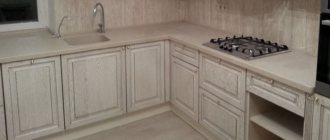Manufacturing and proper installation of a wooden window sill
A modern window sill can be used not only as a stand for flower pots or a work area, but also aesthetically pleasing to the eye, being a decorative element for both a separate room and an entire apartment or private house as a whole. Wooden window sills look especially elegant, the production of which can be made from different types of wood as a single piece or by gluing individual wooden planks. The model is suitable for a plastic window profile covered with film, color and texture reminiscent of natural wood, as well as a wooden window frame.
Main functions, varieties and photos
Useful features:
- Protects the room from cold and drafts.
- Can be used as a shelf for storing flower pots, books, and interior items.
- A place to relax. If the width allows, you can arrange a seating area on it.
- Winter Garden. It can be created by placing decorative vases with flowers on the surface.
- Workplace. With a width of 30 cm or more, you can place a laptop or table lamp on it.
Attention
Methods of use in the room depend on what type and shape it will be.
Varieties:
- Wide - these include elements with a width of 40 cm or more. They are installed only if there are wide supporting walls. They hide the battery well.
- Narrow - no more than 10 cm wide. They have little functionality, so they are often replaced with wider ones.
- Formal - in fact, it is practically absent, its role is played by a small internal slope (how to install a slope?).
- Window sill running onto the wall . The launch width is 15–20 cm.
- Without launching onto the wall - this option allows you to save money by reducing the length.
Wood is an environmentally friendly material , so all elements made from it can be used in apartments where people with allergies, small children and people with problems with the respiratory system live.
You can diversify the look of the interior by choosing a non-standard shape of such an element. It can be straight, which can be seen in every apartment, or arched. Such window elements have curved lines in the form of an arc.
The photo shows examples of wooden structures.
Advantages of installing a wooden window sill
Plastic windows in their normal state are not capable of causing harm to humans. But in winter, when the heating is on, the polymer window sill heats up and can poison the room with toxins. Ventilating a room in the cold season is problematic, so a wooden window sill for a plastic window turned out to be an excellent solution to the problem.
The tree does not have toxic properties, has a pleasant structure, and looks more presentable. In addition, such products can withstand greater loads than their plastic counterparts, which are known for their fragility. All this has led to increased demand for biosafe materials. Nobody wants to put themselves and their family in danger.
Option for painting wooden window sills
Despite the fact that wooden window sills are distinguished by their resistance and durability of painting, sometimes there is a need to refresh them or give them a different shade that is more suitable for the tone of the furniture or walls. And then the question of what and how best to paint wooden window sills becomes especially relevant. To achieve the goal without losing the attractiveness of this important wooden element, there is a wide range of varnishes and paints.
When choosing paint, you need to focus on the following parameters:
- moisture resistance;
- elasticity;
- ability to pass air.
It depends on what material will be purchased for painting wooden window sills.
- reliable protection against moisture penetration and fungal development;
- breathability of wood;
- resistance to cracking.
Alkyd paint for interior work, containing environmentally friendly resins and mineral oil, meets all these criteria. After its use, an excellent waterproof shell is formed on the painted surface, retaining its properties for 5 years.
Among varnishes, the most suitable option for wood is quick-drying acrylic. It has a neutral odor and a high level of environmental safety. But if the wooden window sills are very light, you should give preference to wear-resistant polyurethane varnish. Thanks to its yellow tint, it gives light wood a delicate golden glow.
Careful care, lamination, varnish or wax coating significantly extend the life of wooden products, especially if you plan to place flower pots, heavy crystal vases or marble interior parts on them.
No. 3 – Euro Extra-20 from Tikkurila
If we continue the conversation about environmental friendliness and safety, it is worth noting the product of the Tikkurila company - water-dispersed paint Euro Extra-20. According to the VOC European Directive, this product fully complies with the standards for the content of volatile substances that are safe for health. When applied to surfaces, it does not emit any odor.
A distinctive feature of Euro Extra-20 paint is its excellent moisture resistance. On window sills, which are often exposed to condensation or moisture when watering indoor plants, this is especially true. Having painted a wooden window sill with this paint, you don’t have to worry that it will turn black from mold or swell.
According to the technical specifications, Euro Extra-20 has the following main characteristics:
- consumption when applied to unprimed wooden surfaces – 1 liter per 6 m2;
- drying speed at a temperature of +20 0 C and a humidity of 65% – 4 hours;
- Time to achieve wash resistance is 1 week.
Comparative environmental properties
From the point of view of environmental friendliness, Saicos and Osmo oils meet safety requirements to the maximum. They contain natural ingredients of plant origin.
Just as vegetable oil is useful for humans, natural oil with wax is useful for wood, since it is the most compatible with it.
Natural oil with hard wax contains:
- Sunflower, soybean, linseed oil.
- Natural wax approved for use in the food industry.
- Pigments that do not contain heavy metals.
However, the finishing material should not be considered as edible vegetable oil. In addition to the listed ingredients, it contains various compositions that ensure uniform application of the product to the surface of the wood and the hardness of the coating.
Countertops coated with hard wax oil can be used for cooking. Therefore, for surfaces where contact with food is planned, preference should be given to oil coating.
The varnishes we use, Akzonobel or Hesse Lignal, meet high safety requirements and are made by reliable manufacturers who give preference to high-quality compositions.
A wooden window sill is better, why
- beautiful and modern - welcome in any style,
- natural material is an indisputable fact,
- environmentally friendly - wood is non-toxic,
- durable - average service life is more than 30 years,
- durable and practical - can withstand loads of more than 100 kg,
- repairable - local repair possible
The undoubted advantages of wooden window sills are difficult to dispute, so those who ordered them never regretted it later; our production guarantees quality. And what do slab window sills look like? Just a fairy tale!
Paints and varnishes for interior and exterior window decoration
Alkyd paints are usually used indoors. They have an elastic structure and give the windows an aesthetic appearance. The flexible structure of the coating is achieved thanks to oil inclusions.
For outdoor work, more durable coatings are required, such as acrylic and nitro paint. Such paints and varnishes dry very quickly, and they do not have a strong odor, and after drying, a durable film is formed on the window frame. However, paints are not suitable for window sills. You can figure out how to paint wooden windows only by taking into account the characteristics of different materials.
Preparatory work
After installing the window, there remains a wide gap between the slope and the frame. It’s easier when the window sill is replaced. The opening remains intact; the craftsman only needs to prepare the hole for the panel. It may not always coincide with the dimensions of the new item, then both objects will need to be adjusted.
For sealing you will need polyurethane foam
Preparation may include the following steps:
- Inspection of the panel opening. If necessary, it expands so that it is 2 cm wider than the frame on each side.
- Clean the hole from crumbs and dust, treat it with a mold and mildew agent in accordance with the instructions.
- Raising the level of the support platform if the clearance exceeds 5 cm.
- Cutting out the slab to the required size. The optimal protrusion is considered to be 10-15 cm beyond the wall level. Cutting to width, fitting the product to the opening.
- Rounding corners, grinding and polishing.
- Preparing material for spacers. These can be bars, pieces of plastic and other improvised items.
Finally, the wooden panel is primed and coated with a topcoat.
Preparing the base of the wall
The polyurethane foam must come into direct contact with the wall material. Therefore, the base of the opening is cleared of construction debris and foam that has excessively protruded when foaming the space between the frame and the walls. The foam is also cut out from under the lower window profile to a depth of 2-3 cm to partially pinch the window sill fabric by the window structure.
If the distance between the lower plane of the installed window sill and the base of the wall is less than 1 cm, a recess up to 70 mm wide and 20-30 mm deep is cut into the wall to form a foam seam on which the plastic panel will lie.
Stages of window sill production
The first and most important stage in the production of a wooden product is, of course, drying. The “life” of the product depends on how carefully the drying technology is followed. Well-dried wood does not warp due to temperature changes, does not shrink or crack. Oak wood, for example, can be dried in a kiln for up to 50 days. Properly dried wood should contain no more than 12% moisture content.
Pine is used to produce budget options. More expensive ones are made from maple, ash, beech, oak, larch and even mahogany.
Also, for the production of window sills, you can use furniture panels based on pine slats with veneering of valuable wood species. The quality of such a product is stronger and more reliable than that made from solid wood.
Milled and tongue-and-groove structures must be equipped with a special groove on the bottom side of the structure to improve air circulation. This is necessary to prevent warping.
After the drying stage comes the turn of sanding, impregnation and painting. Wood is impregnated with all kinds of compounds to protect it from damage by bugs, fungus, mold, and also to give it water-repellent or, if necessary, fire-fighting properties.
Finally, the board is prepared and can be shaped into a product according to the drawing. Modern woodworking technologies make it possible to make a window sill from wood of absolutely any shape - from classic to radius and figured. After this, the on-site installation stage begins - the most important and responsible one.
The window sill is mounted in a prepared niche. In the case of a wooden window, the seat has already been prepared, but if the opening is framed in plastic, then it is necessary to install a special profile.
If the board has a standard width, then installation is carried out on ordinary polyurethane foam. And if the projection of the structure exceeds 100 mm, then installation is carried out using special brackets. This method is rare, but it is very reliable. It is not recommended to increase the width too much, since in this case the overhang will block the heating radiator and air circulation will be disrupted, which can lead to condensation and freezing of the window.
Why do you need putty?
Adherents of old technologies use a mixture of rosin, wax and turpentine for priming. Today, such compositions have become obsolete and are rarely used. Construction departments are full of a variety of primers, putties and other compounds intended for painting. Most often, acrylic materials are used to prime the surface of wood. Applying putty includes the following steps:
- The frame is inspected for damage. If metal parts are worn out or have cracks or areas of rust, they are treated with a metal primer.
- Before applying the primer, the surface of the wood is impregnated with an antiseptic. This measure will protect the array from beetles and rot, which will significantly extend the service life of the structure.
- After applying the antiseptic, the frame is re-inspected. Antibacterial impregnation will not cover serious cracks and chips; these are the ones that need to be covered with putty. The procedure is performed in stages, filling the cracks over and over again. If you put a large layer of material on the wood, it will fall off along with the paint.
- If the cleaned window frame is planned to be painted, then the putty is applied in a middle layer (the material will not be visible under the white paint). For processing under varnish and stain, the putty is tinted to match the color of the solid wood. You can also make your own putty composition from epoxy resin and wood fibers.
- First, apply the composition on the chips in one layer and wait for it to dry. After this, the layer is cleaned of nicks and protrusions.
- After drying, apply a second layer and also clean it.
- The procedure is carried out until the frame becomes level.
How to attach wooden window sills
Both platbands and window sills can be installed independently. To do this, you need simple tools - a building level, a square, a foam gun.
Installation work, without experience, is better to trust to specialists.
If the dimensions of the window sill have already been determined, there should be no difficulties with installation. You need to follow the scheme:
- The surface of the window opening is cleaned of dust and debris.
- The opening is covered with a primer.
- Installation of the window sill is done using a building level.
- If the window sill is installed in a panel or brick house, then it must be secured using polyurethane foam.
- Additionally, glued or solid window sills can be fixed using self-tapping screws - they are attached to the window frame. Self-tapping screws are selected in length so that they completely pass through the surface of the box into the window sill board.
- If the window sill in the apartment forms a large ledge, it is additionally strengthened with steel corners and wooden blocks.
Important! In a private wooden house, window sills are installed taking into account the structure (casing) of the window opening.
The finishing of the slopes is completed after the installation of the window sill. You need to act carefully. It is better to cover the surface of the structure with fabric or film so that splashes of mortar or plaster do not fall on it.
You can order wooden window sills from our company. To install window sills, it is better to turn to specialists - then the work will be done faster.
Coloring
To keep window frames clean, cover them with masking tape. Cover the floor under the window sill with newspapers or film. The putty sanded surface is ready for finishing. If you plan to varnish the window sill, treat it with stain, and if painted, use drying oil. It is convenient to apply the paint with a roller; treat the joints with a brush. It is advisable to apply several thin, rather than one thick, coats of paint. The paint will lie smoother.
Repairing and painting a window sill will cost less than installing a new one, will take a little time, and will create less inconvenience.
How to paint wooden window sills with your own hands
A beautiful window sill can safely be called a worthy decoration for any window. And it doesn’t matter what it is: wooden or plastic. Any window can be equipped with a unique window sill with an exclusive design. You can take the easy route by ordering its production from any company. Especially for you, they will create such a masterpiece to order that “you can’t tell it in a fairy tale, you can’t write it with a pen.” Granite, marble, all kinds of composite materials, there are absolutely no problems with this in the modern world.
The second path, more complex, involving the development of new construction specialties, is much more interesting and exciting. This is a DIY repair of an old wooden window sill. Here the result depends only on you and the materials used during restoration work.
For convenience, the entire process of restoring wooden window sills This is its preparation, which includes repair and restoration work and the actual design of the window sill - the creation of a new unique coating.
Window sill finishing: preparatory work
At this stage of restoration work, it is necessary to free the old window sill from thick layers of paint that have accumulated over many years of its use. Here you can use different ways to remove old paint: you can heat it with an iron or a hair dryer and remove layer by layer with a spatula, you can use a remover to remove old paint, you can even burn it with a blowtorch. The choice of method is yours, just don’t think that any of them is easier than others. Whatever method you choose, it will be hard and painstaking work. So you will need patience, stock up on it.
Create a flat surface
Having freed the window sill from the “centuries-old” load of old paint, it’s time to start preparing it for applying a new coating. We arm ourselves with spatulas and putty. Ready-made building mixtures are not suitable here; you will have to make it yourself. We purchase dry finishing putty and deep penetration primer. A dry building mixture diluted with a primer is more durable and less susceptible to mechanical damage.
Precautions during the restoration process
When updating an element of a window unit, it is necessary to take precautions, since some materials are toxic and harmful to human health or skin:
- When working with a remover or a hair dryer, it is necessary to thoroughly ventilate the room, and the skin of your hands can be protected with rubber gloves.
- When sanding a surface with sandpaper, it is recommended to wear a gauze bandage to avoid inhaling dust from the previous coating.
- When painting a window sill, it is also necessary to wear gloves and a gauze bandage, especially when working with an aerosol.
Thus, any window sill can be restored and given an aesthetic appearance. To do this, you need to remove the old paint, wipe out cracks and scratches, level the surface with putty, and choose the right paint.











